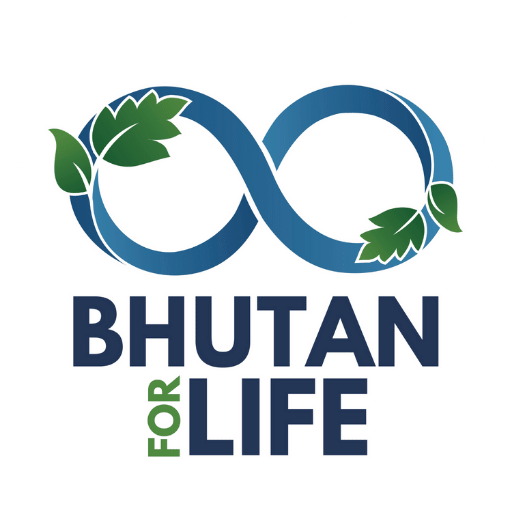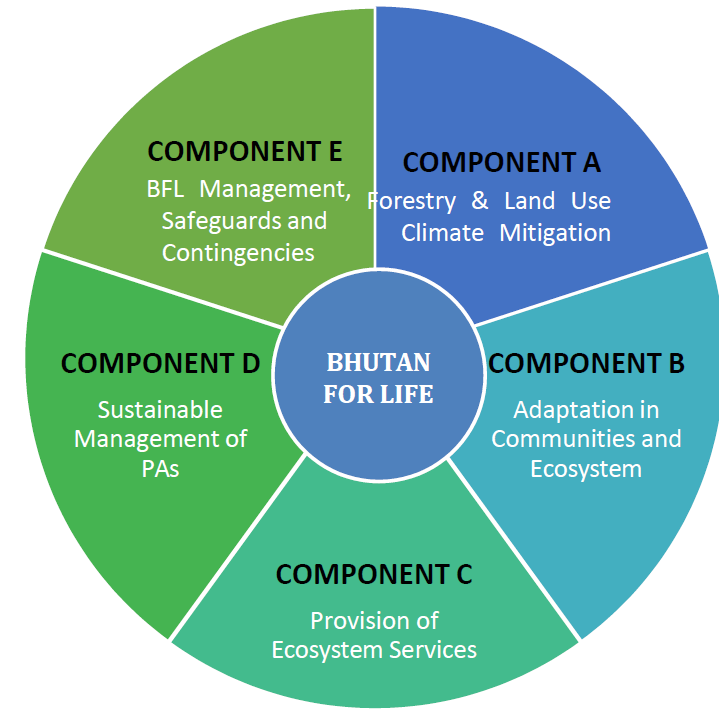Theme
BFL goals (outcomes), milestones (outputs), and activities were identified, refined and costed by a team of protected area managers, central government representatives, and conservation and finance experts from the Royal Government of Bhutan (RGoB) and WWF through a highly detailed, consultative and iterative process. As a result, BFL is organized into five components, with four delivering programmatic results and one dealing with the management activities.
The rationale for BFL program of activities is rooted on the understanding that the integrity of Bhutan’s protected areas, forests and biodiversity is critical to the country’s climate change mitigation and adaptation goals. To these ends, Component A (as well as a large number of activities under Component D) focuses on forestry and land use climate mitigation, specifically working to maintain forest cover within the PAS to help Bhutan remain carbon negative. This is a stated priority of the government, and will help to fulfil international commitments to continue to be a net carbon sink.
Result Areas
To achieve the vision of BFL, the BFL program has over 80 activities contributing towards 16 milestones and four major goals which encompasses the overarching outcomes of BFL. Unlike other PFP models, BFL program strives towards promoting biodiversity conservation in tandem with enhancing community livelihoods and building resilient social-ecological systems against impacts of climate change. BFL focuses on the following result areas:
5 Result Area covers 16 Milestones
Milestone 5: By Year 4, 80% of all households within PAs benefit from reduced human wildlife conflict as a result of adoption of appropriate policies, technologies and systems
Milestone 8: By Year 6, information on the conservation status of 10 other high-profile, lesser known, endangered or endemic flora and fauna species established, and five climate-smart species conservation plans developed (in addition to those for tigers and snow leopards)
Milestone 9: By Year 2, Zero Poaching Framework and SMART/effective patrolling instituted in all PAs/BCs to prevent, combat, and monitor poaching, wildlife trade, and other illegal activities
Milestone 1: From Year 2 onwards, forest quality and extent (at 1.1 million hectares) maintained within the PA network, thereby securing the storage of 240 million tons of carbon dioxide equivalent and increasing climate resilience through forest ecosystem conservation
Milestone 2: By Year 4, degraded lands within the PA network are brought under climate-smart reforestation mechanisms to enhance the carbon stock (above and below gr`ound) and increase climate resiliency
Milestone 3: By Year 8, all communities in PAs value, support, and engage in conservation, including waste management and climate change adaptation
Milestone 4: From Year 7 onwards, all communities living within PAs use traditional knowledge, best available science and technologies to increase their climate and disaster resilience
Milestone 5: By Year 4, 80% of all households within PAs benefit from reduced human wildlife conflict as a result of adoption of appropriate policies, technologies and systems
Milestone 6: By Year 9, 80% of all households within PAs have increased access to nature-based employment and income-generating opportunities including ecotourism and sustainable harvesting of NWFPs, enhancing their resilience to climate change
Milestone 14: By Year 2, the PA network has climate-smart management plans and a system to track management effectiveness, and by Year 6 the PA network is clearly demarcated
Milestone 15: By Year 5, PAs/BCs are equipped with adequate and competent staff, and by Year 10 all PAs/BCs are equipped with essential equipment and infrastructure
Milestone 16: By Year 2, feasibility assessments for new sources of sustainable financing have been completed, and by Year 8, new sources of long-term sustainable financing for Bhutan’s protected area network have been developed, approved by the RGoB, implemented, and are producing funding that is flowing to the PA network
Milestone 10: By Year 6, key high-biodiversity and climate resilience value habitats (and areas that connect them) are under improved management
Milestone 11: By Year 6, at least one high conservation, economically and culturally valued stretch of river linked to a PA is designated as free-flowing and effectively managed to continue to provide important ecosystem services for conservation and climate-resilience of local communities
Milestone 12: By Year 7, watershed conditions in ten critical catchments within the protected area network improved for climate resilience, wildlife and socio-economic development
Milestone 13: By Year 7, National Five Year Plans and all PA management plans incorporate natural capital valuation, key ecosystem services provided by PAs/BCs, and salient climate change risks and mitigation/adaptation strategies


